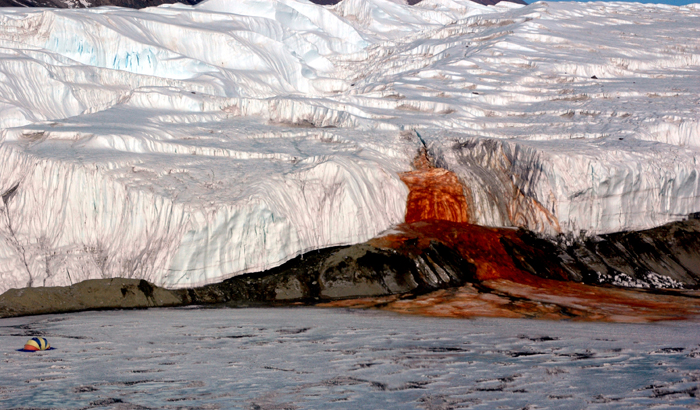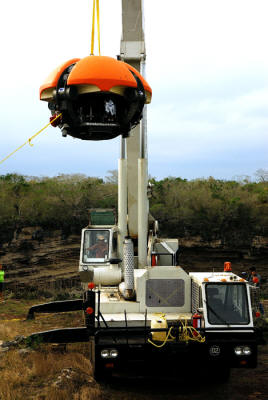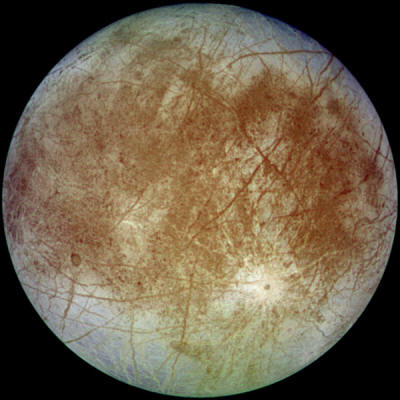|
Antarctic Sun Editor
First, a swim around an ice-covered lake
in Antarctica. Next, through the frozen surface of
Jupiter’s moon Europa and possibly into a vast, liquid ocean that may host life as
we’ve never known it.
Peter Doran, one of several principal investigators engaged in a multi-year study of this unique ecosystem, is leading a team of engineers, planetary scientists from NASA and others in developing a tool that may some day probe an alien ocean.
Blood Falls "pours" out of the Taylor Glacier onto the ice-covered surface of Lake Bonney in the McMurdo Dry Valleys. A robot that scientists will deploy during the 2008-09 season
will detect if the
ancient saltwater deposit is seeping into the water below as it maps
and explores Lake Bonney. Nicknamed ENDURANCE, for Environmentally Non-Disturbing Under-ice Robotic ANtartic Explorer, the $2.3 million project will send an autonomous underwater vehicle (AUV) to Lake Bonney for two field seasons, beginning in November 2008.
An associate professor of earth and environmental sciences at the University of Illinois at Chicago, Doran is interested in how the region’s past climate still influences today’s lake ecosystem, particularly its hydrology, the study of the movement, distribution and quality of water.
For example, today’s lakes are mere
puddles compared to the large bodies of water that once dominated
the valleys, according to Doran. A thick, salty, nutrient-rich layer
of water in Bonney, where most of the lake’s photosynthetic
microorganisms live, is carbon material from the retreat of those
great lakes many millennia ago.
The ability for life to survive in such inhospitable and unusual conditions such as Lake Bonney — or in equally harsh, inconceivable places like thermal vents at the ocean floor and within solid rock – holds out the possibility that organisms might thrive across the stars on distant moons and planets.
Photo Credit: Stone
Aerospace
shown here during
exploration of flooded sink holes in Mexico during 2007.
which may possess water and alien microbial life. “It’s the most important scientific question we can ask: Are we alone? Are we unique?” Doran said. “It’s a scientific question. It’s not some outrageous science fiction question. It’s a real, testable question. … It’s based on the fact that on Earth, wherever we find water, we find life.”
There is a good case for possible life on Europa based on the prerequisite of water, according to Christopher McKay, a planetary scientist at the Space Science and Astrobiology Division at NASA’s Ames Research Center.
He is a co-investigator on the ENDURANCE project.
Stone Aerospace in Texas designed the
robotic probe, which NASA’s Astrobiology Science and Technology for
Exploring Planets (ASTEP) Program funded. It can swim untethered
under the ice, creating three-dimensional maps of the underwater
environments it explores. It carries a suite of instruments that
allow it to measure water characteristics like salinity and acidity,
and probe for evidence of microbial life. It looks a bit like a
giant, stemless Portobello mushroom cap.
An Air Force C-17 will transport the
1,350-kilogram robot to Antarctica. A helicopter will then fly its
component pieces to Lake Bonney, where a construction crew will
build a sort of “garage” around the robot, which the science team
will use to deploy ENDURANCE into the lake.
While there are instruments already in the lake that measure similar properties as the ENDURANCE will, the robot offers the luxury of unfettered movement, Doran noted.
ENDURANCE will spend about a month
mapping and sampling the lake, and then repeat the process the
following season, so Doran and his colleagues can compare changes in
the lake from one season to the next. The data will be important for
their work on the National Science Foundation-funded McMurdo Dry
Valleys Long Term Ecological Research program, a multi-year,
multi-disciplinary study of the ecosystem.
Doran said the ENDURANCE expedition to Lake Bonney would prepare scientists and engineers for the bigger show ahead.
|



